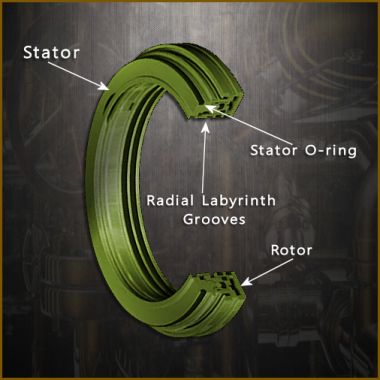Abradable Polymer Labyrinth Seals
Abradable polymer labyrinth seals are a mechanical, dynamic seal based on the original labyrinth seal, but with a curious twist that increases efficiency. They can be made of different materials, but in this post we are going to focus on polymer labyrinth seals, and, more specifically, on modified PTFE abradable polymer labyrinth seals. Here are five fascinating facts about abradable polymer labyrinth seals, starting with some basic facts of abradable labyrinth seals:
5 Fascinating Facts
Fact #1: Abradable labyrinth seals reverse the position of the teeth and seal.
Unlike a standard labyrinth seal, the abradable labyrinth seal is designed with the seal is on the stationary component and the teeth on the dynamic (rotating) component. This is important, because if the teeth and seal come in contact, it is the seal that wears away and not the teeth.
Fact #2: Abradable polymer labyrinth seals can increase efficiency through minimum clearance.
In an abradable labyrinth seal, the seal itself is made of an abradable material. According to Websters dictionary, the word abrade means rub or wear away, especially by friction. In an abradable seal, if the teeth contact the seal, they wear away a bit of the seal. That means the clearance only needs to be enough for assembly and start up.
If contact occurs, the abradable labyrinth seal cuts its own minimum clearance through abrasion between the teeth and the abradable surface. Remember, also, that labyrinth seals work by providing a complex pathway that reduces the kinetic energy of the fluid that is trying to escape: abrasion to the seal by the teeth would only increase the complexity of that path.
Fact #3: Abradable polymer labyrinth seals allow the mating surfaces to contact without severe damage.
If the teeth come in contact with the seal, the seal is worn away in the shape of the teeth and damage is limited (remember, it was already designed with less clearance than most mechanical seals require). Without an abradable seal, contact could mean a damaged seal, potential leakage, and vibration, in a best case scenario; in a worst case scenario there could be a catastrophic failure.
Fact #4: Abradable polymer labyrinth seals can excel where other seals fail.
Abradable seals work very well when the stationary and rotating element are in very close proximity to each other, leaving very little clearance to work with. They are also well adapted to situations when the rotating element grows radially or axially toward the stationary element.
Fact #5: Abradable labyrinth seals are often made of modified polymers.
There are several different materials used for the abradable seal portion, such as honeycombed Hastelloy, felted metal, and modified polymers. One popular choice is a LCTE (low coefficient of thermal expansion) modified PTFE. By having PTFE as is base, these seals offer very low friction, a wide range of service temperatures, resistance to chemicals such as lubricants and fuels, and a coefficient of linear expansion on the same order as aluminum.
IN CONCLUSION…
The next time you are faced with a challenging seal problem, such as a rotating element that grows radially, think abradable polymer labyrinth seals.
Here is some additional posts to assist you with Polymer Seals and Polymer Labyrinth Seals:
{{cta(‘816db252-d18f-4800-9203-5429f4eed4fc’,’justifyfull’)}}

